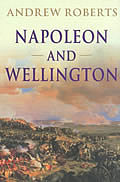Book
Review:
Napoleon and Wellington
By
Andrew Roberts
 We
know from much reported statements by the two leading generals
of the Napoleonic Era - Napoleon Bonaparte, emperor of the French,
and Arthur Wellesley, Duke of Wellington - that they had differing
opinions of each other. But how did they really regard each other?
We
know from much reported statements by the two leading generals
of the Napoleonic Era - Napoleon Bonaparte, emperor of the French,
and Arthur Wellesley, Duke of Wellington - that they had differing
opinions of each other. But how did they really regard each other?
Did
Bonaparte really believe that the British general, who regularly
defeated some of his top marshals in the Peninsular War, was not
a serious opponent?
Did
Wellington truly think that Bonaparte's hat was worth 40,000 men
on the battlefield? What did he privately tell people?
A
book from academic and prize-winning author, Andrew Roberts, Napoleon
and Wellington, delves into what the enemies said publicly
and what they thought privately.
Roberts
begins by mapping an interesting comparative chronology of the
pair with key events on facing pages and then goes on to detail
similarities in the men's ages, upbringings and relationships.
While
Bonaparte rose much higher and had an almost all-conquering political
and military career, Wellington was never overawed by his opponent
and, in fact, did not consider him to have the same level of martial
skills as his own.
He
privately criticised the emperor's campaigning and lack of caution.
As a man who tried to limit his own casualties, Wellington also
was not enamoured with Bonaparte's willingness to sacrifice lives
for his ambitions.
In
fact, the Anglo-Irish aristocrat sneered at Bonaparte's early
social status and called him Buonaparte, the original Italian
spelling of his name, to try to put him in his social place.
Wellington
never regarded Bonaparte as a gentleman and took great pleasure
in pointing out his Corsican nature when the French emperor did
what the Englishman thought was vengeful behaviour. The kidnapping
and execution of the Duc d'Enghien gave Wellington ammunition,
as did Bonaparte's inclusion in his will a large sum of money
for the man charged with trying to assassinate his British opponent.
On
his part, Bonaparte refused - until very late in the Peninsular
War - to acknowledge Wellington's obvious military abilities.
He
had, after all, defeated every general and marshal the French
could put up against him, and did so with a smaller army. And
by tying down so many veteran French troops in Spain, as well
as helping to sink the idea of French invincibility, Wellington
opened the door for Bonaparte's eventual defeat.
Nevertheless,
the French leader dismissed Wellington as a "Sepoy General", a
derogatory statement meaning that because the Englishman did well
against Indian troops, it was another matter against veteran European
ones. Bonaparte did not know, or refused to accept, that some
of the Indian princes had European trained armies and were particularly
good fighters.
Of
course the two greatest generals of the age met only once on the
battlefield and in that Wellington showed how he could see off
the French in the same old way. Bonaparte's dismissal of the British
on the morning of the great battle may have only been to bolster
his more cautious commanders - many of whom had fought Wellington
- but it did open the way for suggestions that the French emperor
approached Waterloo with an unrealistic overconfidence.
In
Napoleon and Wellington, Roberts devotes 150 pages to the
great military clash and then follows up with some excellent information
on the post-Waterloo struggle of rivalry and propaganda between
the pair.
Wellington,
who had helped protect Bonaparte from the vengeful Prussians,
was clearly upset by the offer of money to his would-be assassin,
and called the deposed emperor a "shabby fellow".
From
exile, Bonaparte began his greatest campaign - that of creating
the Napoleonic legend - and clearly won the exchange.
Roberts
delves into the boudoirs of both men and how Wellington, whether
deliberately or not, struck up very, very close friendships with
two of Bonaparte's lovers, hired some of his former staff and
even bought from Pauline Bonaparte her large home in Paris for
use as the British Embassy.
At
350 pages, Napoleon and Wellington is a considerable work
and is filled with many interesting facts and side stories. Its
detail is absorbing and certainly opens up many channels for discussion,
although it sometimes becomes a little wordy.
The
book includes 16 pages of colour and black and white images of
the leading characters of the period and each is of very high
printed quality. The whole feel of Napoleon and Wellington
is one of quality production and it will sit well in any serious
library.
Roberts has done the study of the Napoleonic Era a tremendous
amount of good in opening up the minds of the rivals to public
gaze. It is fair to say that having read Napoleon and Wellington,
you will look at the great struggle in a very different light.
-
Richard Moore
8.5/10